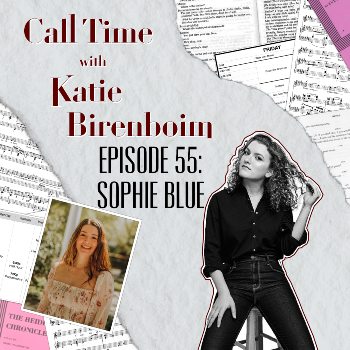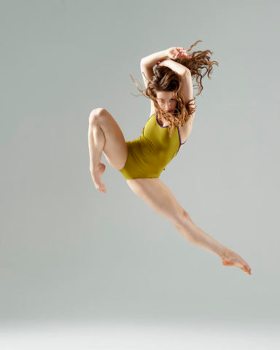
I’ve been wanting to interview my classmate Sophie Blue for virtually as long as I’ve been a graduate student. From day one, I could tell that Sophie was articulate, hard-working, had an interesting work experience and professional background, and, most importantly, thought about things differently than how I approached them. For example, Sophie was always introducing issues of technology and accessibility to our classroom, subjects that are certainly relevant and important to me, but with which I am less familiar. When our professor asked about ways we could dispel the myth that the arts are only for an elite few, Sophie brought up ways that programming could use technology to be more accessible for people with attention issues or other disabilities, and how this media could help the field evolve. As a millenial for whom changing my password to Spotify still gives me the hives (true story), I was fascinated by this fresh and innovative approach to art-making.
It also represented one of the first times I became conscious of my own age. Readers may laugh, but before encountering Sophie, and others in my graduate program, I was used to being the youngest person “in the room,” and I felt as if most of my peers and classmates, even if they had been two-three years behind me in school, thought about life and art in much the same way that I did. Meeting Sophie, and others I’d categorize more in the “Gen Z” bucket, was one of the first times I became conscious of my own age, not only because she’s in her early twenties and I’m in my late twenties, but also because she so clearly thought about things differently. Sophie was talking about how the arts could harness Tik Tok for more than just marketing, and I didn’t quite know what a Tik Tok was (that’s since been remedied). I could sense a palpable difference in perspective, and that excited me.
To that extent, when interviewing Sophie I went out on a limb to summarize her work as existing at the nexus of art and technology. Funnily enough, Sophie said she had never articulated it in that way — though she liked the term, and I definitely feel it’s fitting. In fact, it seems as if Sophie has always approached art from a slightly lopsided, “what if we turned this on its head?” angle. It’s why she turned to modern and contemporary dance, as opposed to ballet, when she was faced with the limitations of the ballet world (indeed, Sophie and I go in-depth about what it means to have the “ballet body” and “ballet facility” today).

It’s why she’s purposefully pursued opportunities to make dance more accessible, especially to individuals with special needs, at nearly every step of her career — helping to found the Youth Dancers program within the Trenton Arts at Princeton initiative, taking classes like Music Therapy at NYU, and working in education (her fellowship at Jacob’s Pillow). It’s why she came out of Princeton, after continuing to dance with student organizations as well as the dance department, and decided to pursue arts administration, realizing that she loved the leadership opportunities, where she felt she could use all sides of her brain, all of her skills, and have a coherent voice in the actual art-making.

But it’s also why, despite pursuing arts administration professionally — and to great success, I might add — Sophie hasn’t ruled anything out from her professional life. One of my favorite parts of our conversation was when I asked her about her decision to move to arts administration in various capacities, rather than pursue a professional career as a contemporary dancer, and I added the caveat that it is my personal belief that pursuing these opportunities and this degree now doesn’t rule anything out for Sophie, or for anyone else, in the future. “I’m so glad you said that,” Sophie replied. “People tend to think that once you stop dancing in that same way, you’re done. But dance is something that I’m still training in — that I believe I’m going to return to — just not on anyone else’s schedule.”
It’s sort of the thesis of my show: we are (thankfully) entering a time and space in the arts where people don’t have to categorize themselves as any one thing — in fact, it’s celebrated to wear many different hats and have many different skills. And while I applaud the people who have always wanted to be solely an actor, solely a dancer, solely a musician, etc., I’m most interested in the people who have rejected the ways that the industry tries to shoehorn us and have instead stretched the bounds of what art-making can look like and be.
It’s another reason why Sophie’s age is exciting to me. When I graduated from college wayyyyy back in 2016, the theatre industry was still very much in the business of categorizing. “You can’t take this assistant directing job,” I remember one person counseling me in fall of 2016, “because then people will start to think of you as a director, and then casting directors will NEVER think of you as an actor again.” It was frustrating, and it imbued a lot of my other interests and passions in life with a lot of fear and shame. While actors are still “type-cast” every day, and that probably won’t change — it’s a fundamental reality of casting and shaping a show, I feel lucky that we seem to be moving into an age and space where the “multi-hyphenate” is celebrated. Of course, this work goes hand-in-hand with the broader issues the industry has been forced to tackle in recent years, or even just since the pandemic, like systemic racism, sexism, and unequal working conditions. As I expressed in my very first Arts Journal article, it’s my belief that if the industry must be reshaped and rethought in order to address these systemic problems, the charge must be led by artists who are in the business of reshaping their own careers, desires, and artistic pursuits.
And that’s why it’s so exciting that fluidity, innovation, resourcefulness, scrappiness, and willingness to think differently come so easily to someone like Sophie. It indicates to me that this “new generation” of artists — call them Gen Z, or whatever you will — perhaps even more than my own, are ready, willing, and able to lead this charge and to think differently. “It’s kind of an old guard way of thinking a lot of the time in the arts,” Sophie said in our interview. “We need a new approach.”
Listen to our full interview here, where Sophie and I also discuss her work with UK-based choreographer/dancer Liam Francis, the power of networking, looking for structure as an artist, the ritual of ballet class, running (dancing) in a circle, Joseph Pilates, and re-living my glory days as a Berkshires arts intern.


Leave a Reply